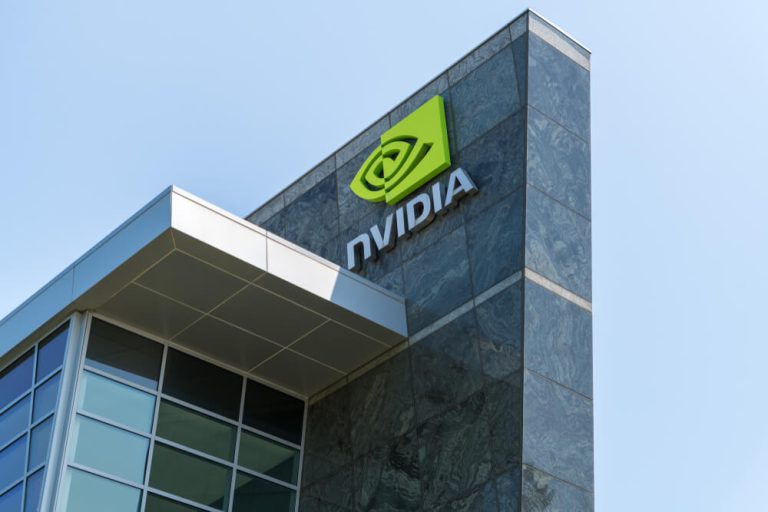Nvidia Stock Soars 9% After Record Q1 Earnings
Quick Look:
Spectacular Financial Performance: Q1 fiscal 2025 revenue surged 262% to $26 billion; adjusted EPS jumped 461% to $6.12.
Leadership in AI and Data Centres: Dominance in AI research and data centre markets ensures a stable, growing revenue stream.
Elite Market Position: Part of the “Magnificent Seven” tech giants, boosting investor confidence and market influence.
On May 23, Nvidia saw its stock skyrocket by 9%, hitting a new all-time high following the release of its latest earnings report. In the first quarter of fiscal 2025, ending April 28, the chipmaker experienced a remarkable 262% year-over-year surge in revenue, reaching $26 billion, surpassing analysts’ expectations by $1.5 billion. Additionally, Nvidia’s adjusted earnings per share (EPS) leapt 461% to $6.12, outpacing consensus forecasts by $0.54. These explosive growth rates have led many to question whether Nvidia’s stock still has upward potential after a staggering 2,720% rally over the past five years. Here, we delve into four compelling reasons to buy Nvidia’s stock, along with four reasons to approach with caution.
Reasons to Buy Nvidia Stock
1. Unmatched Growth in Revenue and Earnings
Nvidia’s recent financial performance has been nothing short of spectacular. The company’s ability to outpace revenue and earnings estimates by significant margins highlights its robust operational execution and strategic positioning in the market. In fiscal 2025, Nvidia’s revenue surged 262% year over year to $26 billion, and its adjusted EPS increased by 461% to $6.12. These figures represent a remarkable turnaround from fiscal 2023, where Nvidia faced stagnation due to a slowdown in gaming GPU sales and macroeconomic headwinds affecting its data centre segment.
2. Dominance in AI and Data Centres
Nvidia’s leadership in artificial intelligence (AI) and data centre markets is a significant growth driver. The company’s GPUs are at the forefront of AI research and applications, making them indispensable to tech giants and research institutions. This dominance in AI, coupled with strong demand for data centre solutions, provides Nvidia with a stable and expanding revenue stream. The ongoing AI revolution is likely to sustain high demand for Nvidia’s products, driving long-term growth.
3. Market Position Among the Magnificent Seven
Nvidia is part of the so-called Magnificent Seven, a group of tech behemoths including Apple, Amazon, Meta, Alphabet, Tesla, and Microsoft. These companies collectively account for about 20.7% of hedge funds’ total net exposure to US single stocks. Nvidia’s inclusion in this elite group underscores its critical role in the tech ecosystem and its influence on market dynamics. The collective performance of these tech titans can amplify investor confidence and provide a buffer against market volatility.
4. Rising Market Capitalization
Since its latest earnings report, Nvidia has added approximately $470 billion to its market capitalization, reflecting investor enthusiasm and confidence in its future prospects. This significant increase in market cap is indicative of Nvidia’s perceived value and growth potential. Investors often view rising market capitalization as a positive signal of a company’s health and market dominance, which can attract further investment and drive stock prices higher.
Reasons to Be Cautious
1. Valuation Concerns
Nvidia’s stock valuation has reached lofty heights, raising concerns about its sustainability. After a 2,720% rally over five years, some investors may find the stock overvalued compared to its historical metrics and industry peers. High valuations can lead to increased volatility and potential corrections, especially if future earnings fail to meet heightened expectations.
2. Dependency on the AI Hype
While Nvidia’s leadership in AI is a significant advantage, it also poses a risk if the AI market growth slows or fails to meet optimistic projections. The current frenzy around AI has significantly boosted Nvidia’s stock, but any downturn in AI adoption rates or technological breakthroughs by competitors could adversely impact its growth trajectory.
3. Competitive Pressures
The semiconductor industry is highly competitive, with major players like AMD, Intel, and emerging competitors constantly innovating. Nvidia must continually invest in R&D to maintain its competitive edge. Any slip in technological advancements or market positioning could result in loss of market share and revenue.
4. Macro-Economic Uncertainties
Global economic conditions and geopolitical tensions can influence Nvidia’s performance. Factors such as trade disputes, supply chain disruptions, and changes in government policies can impact the semiconductor industry. Nvidia’s global operations make it susceptible to these macroeconomic risks, which could affect its financial stability and growth prospects.
In conclusion, Nvidia’s recent financial performance and strategic positioning in AI and data centres present strong arguments for continued investment. However, investors should remain cautious of valuation concerns, dependency on AI market dynamics, competitive pressures, and macroeconomic uncertainties. Balancing these factors will be crucial for making informed investment decisions regarding Nvidia’s stock.
The post Nvidia Stock Soars 9% After Record Q1 Earnings appeared first on FinanceBrokerage.



